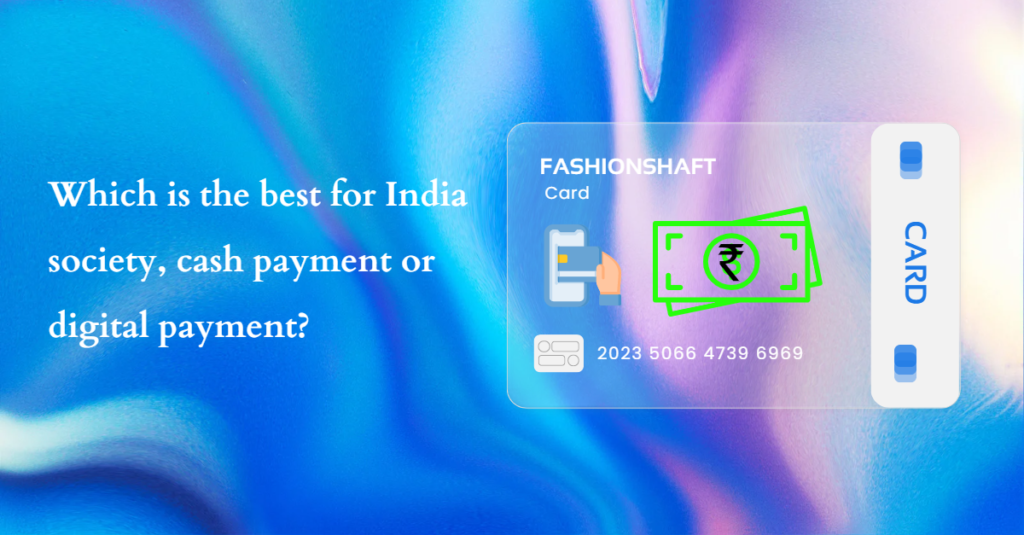Which is the best for India society, cash payment or digital payment?
Introduction
The debate over which payment method is best for Indian society, cash or digital, has been ongoing for some time now. While cash has been the dominant mode of payment for many years, the rise of digital payments has brought about a shift in the way people transact. Digital payments offer numerous advantages over cash, such as convenience, security, and speed. They also allow for easier tracking of transactions, making it simpler to keep a tab on expenses. However, cash still holds a significant position in India, with many people preferring it for various reasons.
In this article, we will delve into the advantages and disadvantages of both cash and digital payments to determine which payment method is the best fit for Indian society.
Advantages of Digital Payments in India
Digital payments have gained popularity in India in recent years, and there are several reasons for it. One of the main advantages of digital payments is that they reduce corruption. Digital payments leave behind a trail of transactions that can be easily tracked, making it difficult for people to evade taxes and engage in illegal activities such as money laundering.
Moreover, digital payments promote financial inclusion. A significant proportion of the Indian population does not have access to formal banking services, which makes it challenging for them to conduct financial transactions. Digital payment methods such as mobile wallets and UPI have made it possible for these people to transact digitally, improving their financial inclusion.
Digital payments are also convenient and fast. Gone are the days when you had to stand in long queues to pay your bills or transfer money. With digital payment methods, you can transact from the comfort of your home or office with just a few clicks. Moreover, digital payments are processed in real-time, which means that the recipient receives the money instantly.
Finally, digital payments are secure. While there is a risk of cybercrime, digital payment providers invest heavily in security measures such as encryption and two-factor authentication to protect their customers’ data and transactions. Moreover, the government has introduced several measures to promote digital payments, such as the introduction of BHIM (Bharat Interface for Money), which is a secure, fast, and reliable digital payment platform.
Disadvantages of Digital Payments in India
Despite the advantages, digital payments also have their drawbacks. One of the main disadvantages of digital payments is that they require access to digital infrastructure, such as smartphones and internet connectivity. While access to digital infrastructure has improved significantly in recent years, there are still many areas in India where people do not have access to these services. This can exclude a significant proportion of the population from participating in the digital economy.
Moreover, there is a risk of cybercrime. Digital payment providers invest heavily in security measures, but hackers are constantly finding new ways to steal money and data. Cybercrime is a significant concern in India, and people need to take adequate precautions to protect themselves from it.
Finally, digital payments can be expensive. While digital payment providers offer many services for free, there are some charges associated with using these services. For example, banks may charge a fee for transferring money using UPI, and merchants may have to pay a fee to accept digital payments. These charges can be a significant burden for small businesses and people who do not have a lot of money to spare.
Advantages of Cash Payments in India
Cash continues to be a significant mode of payment in India, particularly in rural areas where access to digital infrastructure is limited. Cash payments have several advantages over digital payments.
One of the main advantages of cash payments is that they offer privacy and anonymity. With cash payments, there is no record of the transaction, which means that people can transact without leaving a trail. This is particularly important for people who want to keep their financial transactions private.
Moreover, cash payments are widely accepted in India. Most merchants and service providers accept cash, which makes it a convenient payment method for many people. Additionally, cash payments are not subject to any charges, which makes it a cost-effective payment method for small businesses and people who are financially constrained.
Another advantage of cash payments is that it can be a lifeline in times of crisis. For example, during natural disasters or power outages, digital payments may not be possible, and cash payments become essential.
Disadvantages of Cash Payments in India
While cash payments have several advantages, they also have their drawbacks. One of the main disadvantages of cash payments is that it can fuel the black economy. Cash transactions leave no trace, which makes it easier for people to engage in illegal activities such as tax evasion and money laundering. This can have a significant impact on the country’s economy and lead to a loss of revenue for the government.
Moreover, cash payments can be unsafe. Carrying large amounts of cash can make people vulnerable to theft and robbery. In addition, counterfeit currency is a significant problem in India, and people need to be careful when accepting cash payments.
Finally, cash payments can be inconvenient. With cash payments, people need to physically visit the bank or ATM to withdraw money. This can be time-consuming and can make it difficult for people who are unable to visit the bank or ATM regularly.
Which is Best Suited for India Society, Cash or Digital Payments?
While both cash and digital payments have their advantages and disadvantages, digital payments are the more practical mode of payment for Indian society. Digital payments offer several benefits that outweigh the advantages of cash payments. First and foremost, digital payments are highly convenient and accessible, making it easier for people to transact. They offer a secure and fast mode of payment, eliminating the need for manual counting and reducing the risk of theft and loss. Additionally, digital payments come with the added advantage of earning rewards points and cashback, making them a cost-effective mode of payment.
Digital payments are also in line with the government’s push for a digital economy. The Indian government has launched several initiatives, including the Digital India campaign, to promote the use of digital payments across the country. Digital payments can help reduce corruption, promote financial inclusion, and improve the overall efficiency of the economy.
Conclusion
In conclusion, both cash and digital payments have their advantages and disadvantages. While digital payments offer convenience, speed, and security, they require access to digital infrastructure, and there is a risk of cybercrime. Cash payments offer privacy and anonymity and are widely accepted, but they can fuel the black economy and can be unsafe.
Ultimately, the best payment method for Indian society depends on several factors, including the individual’s preference, location, and access to digital infrastructure. The government should continue to promote digital payments and invest in digital infrastructure to ensure that everyone has access to these services. At the same time, it should also ensure that people who do not have access to digital infrastructure can transact using cash without being excluded from the economy. By striking a balance between cash and digital payments, India can build a robust, inclusive, and sustainable economy.

My name is Rohit Vagh and I’m a content writer specializing in fashion and lifestyle. I have three years of experience in this field and have written various articles. My writing style is creative and engaging, and I strive to create content that resonates with my readers. I have a deep passion for fashion and am constantly researching the latest trends and styles to make sure my readers are up to date. I’m excited to continue my career in blogging, and I’m always looking for new opportunities in the fashion and lifestyle space.





